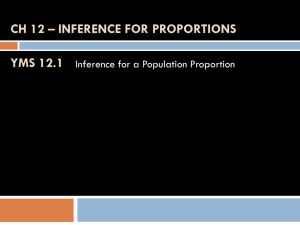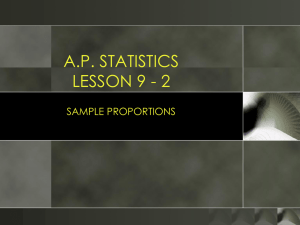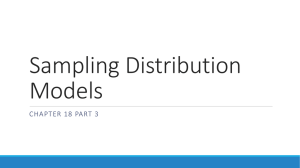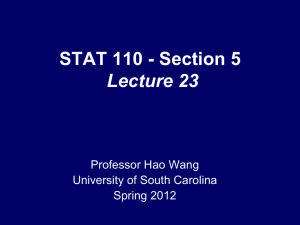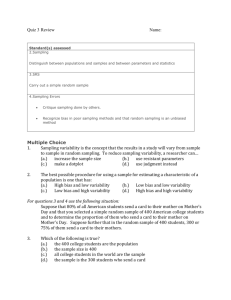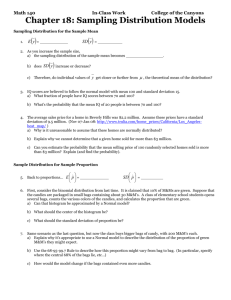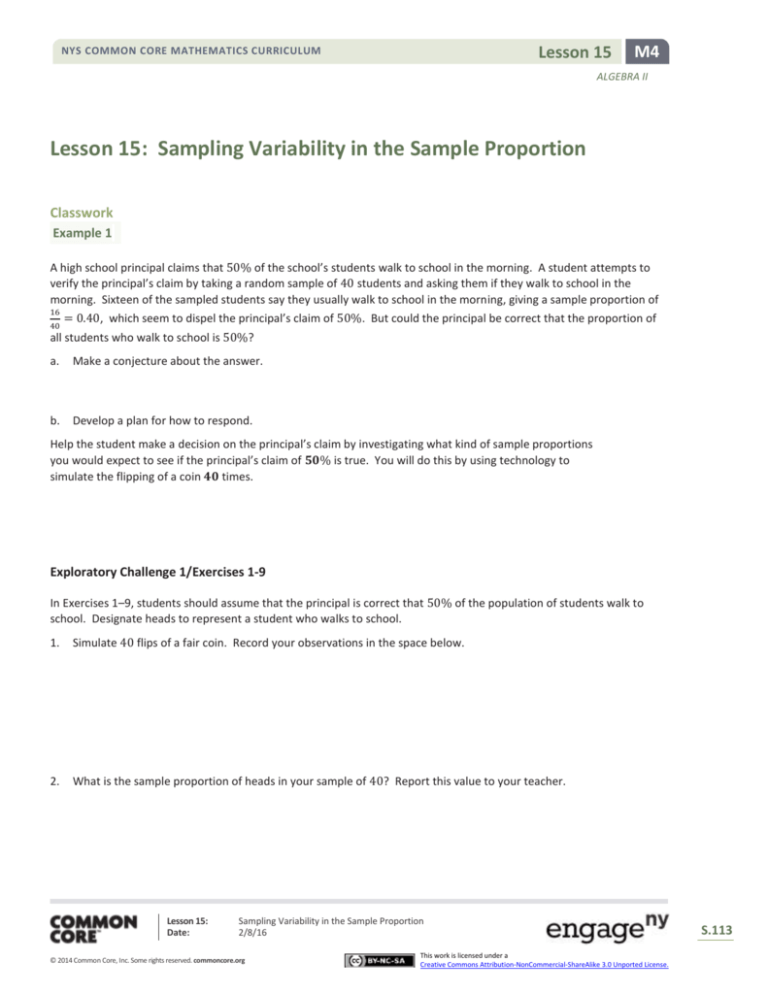
Lesson 15
NYS COMMON CORE MATHEMATICS CURRICULUM
M4
ALGEBRA II
Lesson 15: Sampling Variability in the Sample Proportion
Classwork
Example 1
A high school principal claims that 50% of the school’s students walk to school in the morning. A student attempts to
verify the principal’s claim by taking a random sample of 40 students and asking them if they walk to school in the
morning. Sixteen of the sampled students say they usually walk to school in the morning, giving a sample proportion of
16
40
= 0.40, which seem to dispel the principal’s claim of 50%. But could the principal be correct that the proportion of
all students who walk to school is 50%?
a.
Make a conjecture about the answer.
b.
Develop a plan for how to respond.
Help the student make a decision on the principal’s claim by investigating what kind of sample proportions
you would expect to see if the principal’s claim of 𝟓𝟎% is true. You will do this by using technology to
simulate the flipping of a coin 𝟒𝟎 times.
Exploratory Challenge 1/Exercises 1-9
In Exercises 1–9, students should assume that the principal is correct that 50% of the population of students walk to
school. Designate heads to represent a student who walks to school.
1.
Simulate 40 flips of a fair coin. Record your observations in the space below.
2.
What is the sample proportion of heads in your sample of 40? Report this value to your teacher.
Lesson 15:
Date:
Sampling Variability in the Sample Proportion
2/8/16
© 2014 Common Core, Inc. Some rights reserved. commoncore.org
This work is licensed under a
Creative Commons Attribution-NonCommercial-ShareAlike 3.0 Unported License.
S.113
Lesson 15
NYS COMMON CORE MATHEMATICS CURRICULUM
M4
ALGEBRA II
3.
Repeat Exercises 1 and 2 to obtain a second sample of 40 coin flips.
Your teacher will display a graph of all the students’ sample proportions of heads.
4.
Describe the shape of the distribution.
5.
What was the smallest sample proportion observed?
6.
What was the largest sample proportion observed?
7.
Estimate the center of the distribution of sample proportions.
Your teacher will report the mean and standard deviation of the sampling distribution created by the class.
8.
How does the mean of the sampling distribution compare with the population proportion of 0.50?
Lesson 15:
Date:
Sampling Variability in the Sample Proportion
2/8/16
© 2014 Common Core, Inc. Some rights reserved. commoncore.org
This work is licensed under a
Creative Commons Attribution-NonCommercial-ShareAlike 3.0 Unported License.
S.114
Lesson 15
NYS COMMON CORE MATHEMATICS CURRICULUM
M4
ALGEBRA II
9.
Recall that a student took a random sample of 40 students and found that the sample proportion of students who
walk to school was 0.40. Would this have been a surprising result if the actual population proportion were 0.50 as
the principal claims?
Example 2: Sampling Variability
What do you think would happen to the sampling distribution you constructed in the previous exercises had everyone in
class taken a random sample of size 80 instead of 40? Justify your answer. This will be investigated in the following
exercises.
Exploratory Challenge 2/Exercises 10-22
10. Use technology and simulate 80 coin flips. Calculate the proportion of heads. Record your results in the space
below.
11. Repeat flipping a coin 80 times until you have recorded a total of 40 sample proportions.
.
Lesson 15:
Date:
Sampling Variability in the Sample Proportion
2/8/16
© 2014 Common Core, Inc. Some rights reserved. commoncore.org
This work is licensed under a
Creative Commons Attribution-NonCommercial-ShareAlike 3.0 Unported License.
S.115
Lesson 15
NYS COMMON CORE MATHEMATICS CURRICULUM
M4
ALGEBRA II
12. Construct a dot plot of the 40 sample proportions.
13. Describe the shape of the distribution.
14. What was the smallest proportion of heads observed?
15. What was the largest proportion of heads observed?
16. Using technology, find the mean and standard deviation of the distribution of sample proportions.
17. Compare your results with the others in your group. Did you have similar means and standard deviations?
18. How does the mean of the sampling distribution based on 40 simulated flips of a coin (Exercise 1) compare to the
mean of the sampling distribution based on 80 simulated coin flips?
19. Describe what happened to the sampling variability (standard deviation) of the distribution of sample proportions as
the number of simulated coin flips increased from 40 to 80.
Lesson 15:
Date:
Sampling Variability in the Sample Proportion
2/8/16
© 2014 Common Core, Inc. Some rights reserved. commoncore.org
This work is licensed under a
Creative Commons Attribution-NonCommercial-ShareAlike 3.0 Unported License.
S.116
Lesson 15
NYS COMMON CORE MATHEMATICS CURRICULUM
M4
ALGEBRA II
20. What do you think would happen to the variability (standard deviation) of the distribution of sample proportions if
the sample size for each sample were 200 instead of 80? Explain.
21. Recall that a student took a random sample of 40 students and found that the sample proportion of students who
walk to school was 0.40. If the student had taken a random sample of 80 students instead of 40, would this have
been a surprising result if the actual population proportion was 0.50 as the principal claims?
22. What do you think would happen to the sampling distribution you constructed in the previous exercises if everyone
in class took a random sample of size 80 instead of 40? Justify your answer.
Lesson 15:
Date:
Sampling Variability in the Sample Proportion
2/8/16
© 2014 Common Core, Inc. Some rights reserved. commoncore.org
This work is licensed under a
Creative Commons Attribution-NonCommercial-ShareAlike 3.0 Unported License.
S.117
Lesson 15
NYS COMMON CORE MATHEMATICS CURRICULUM
M4
ALGEBRA II
Lesson Summary
The sampling distribution of the sample proportion can be approximated by a graph of the sample proportions for
many different random samples. The mean of the sample proportions will be approximately equal to the value of
the population proportion.
As the sample size increases, the sampling variability in the sample proportion decreases – the standard deviation
of the sample proportions decreases.
Problem Set
1.
A student conducted a simulation of 30 coin flips. Below is a dot plot of the sampling distribution of the proportion
of heads. This sampling distribution has a mean of 0.51 and a standard deviation of 0.09.
a.
Describe the shape of the distribution.
b.
Describe what would have happened to the mean and the standard deviation of the sampling distribution of
the sample proportions if the student had flipped a coin 50 times, calculated the proportion of heads, and
then repeated this process for a total of 30 times.
2.
What effect does increasing the sample size have on the mean of the sampling distribution?
3.
What effect does increasing the sample size have on the standard deviation of the sampling distribution?
4.
A student wanted to decide whether or not a particular coin was fair (i.e., the probability of flipping a head is 0.5).
She flipped the coin 20 times, calculated the proportion of heads, and repeated this process a total of 40 times.
Below is the sampling distribution of sample proportions of heads. The mean and standard deviation of the
sampling distribution is 0.379 and 0.091. Do you think this was a fair coin? Why or why not?
Lesson 15:
Date:
Sampling Variability in the Sample Proportion
2/8/16
© 2014 Common Core, Inc. Some rights reserved. commoncore.org
This work is licensed under a
Creative Commons Attribution-NonCommercial-ShareAlike 3.0 Unported License.
S.118
Lesson 15
NYS COMMON CORE MATHEMATICS CURRICULUM
M4
ALGEBRA II
5.
The same student flipped the coin 100 times, calculated the proportion of heads, and repeated this process a total
of 40 times. Below is the sampling distribution of sample proportions of heads. The mean and standard deviation
of the sampling distribution is 0.405 and 0.046. Do you think this was a fair coin? Why or why not?
Lesson 15:
Date:
Sampling Variability in the Sample Proportion
2/8/16
© 2014 Common Core, Inc. Some rights reserved. commoncore.org
This work is licensed under a
Creative Commons Attribution-NonCommercial-ShareAlike 3.0 Unported License.
S.119

